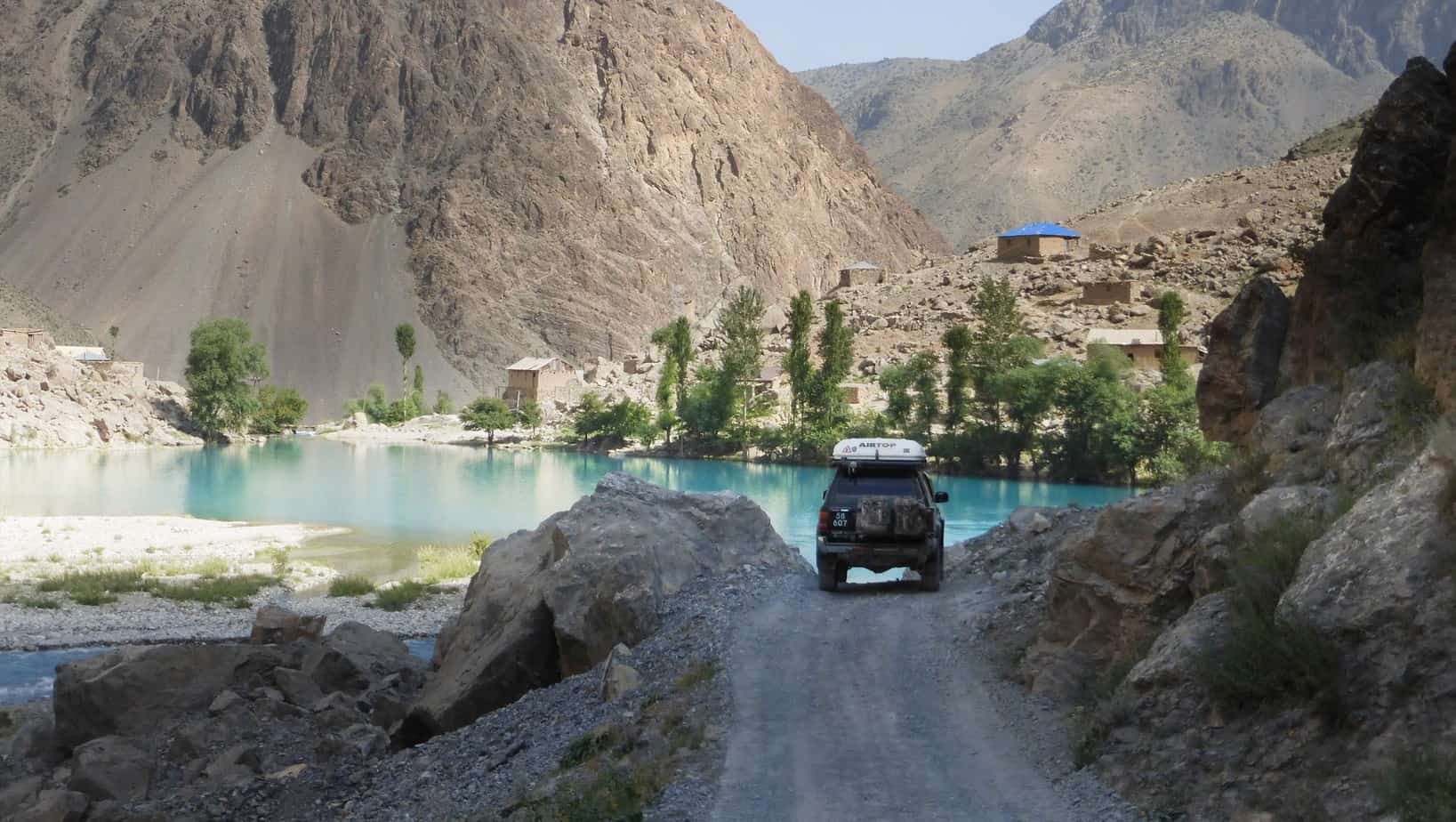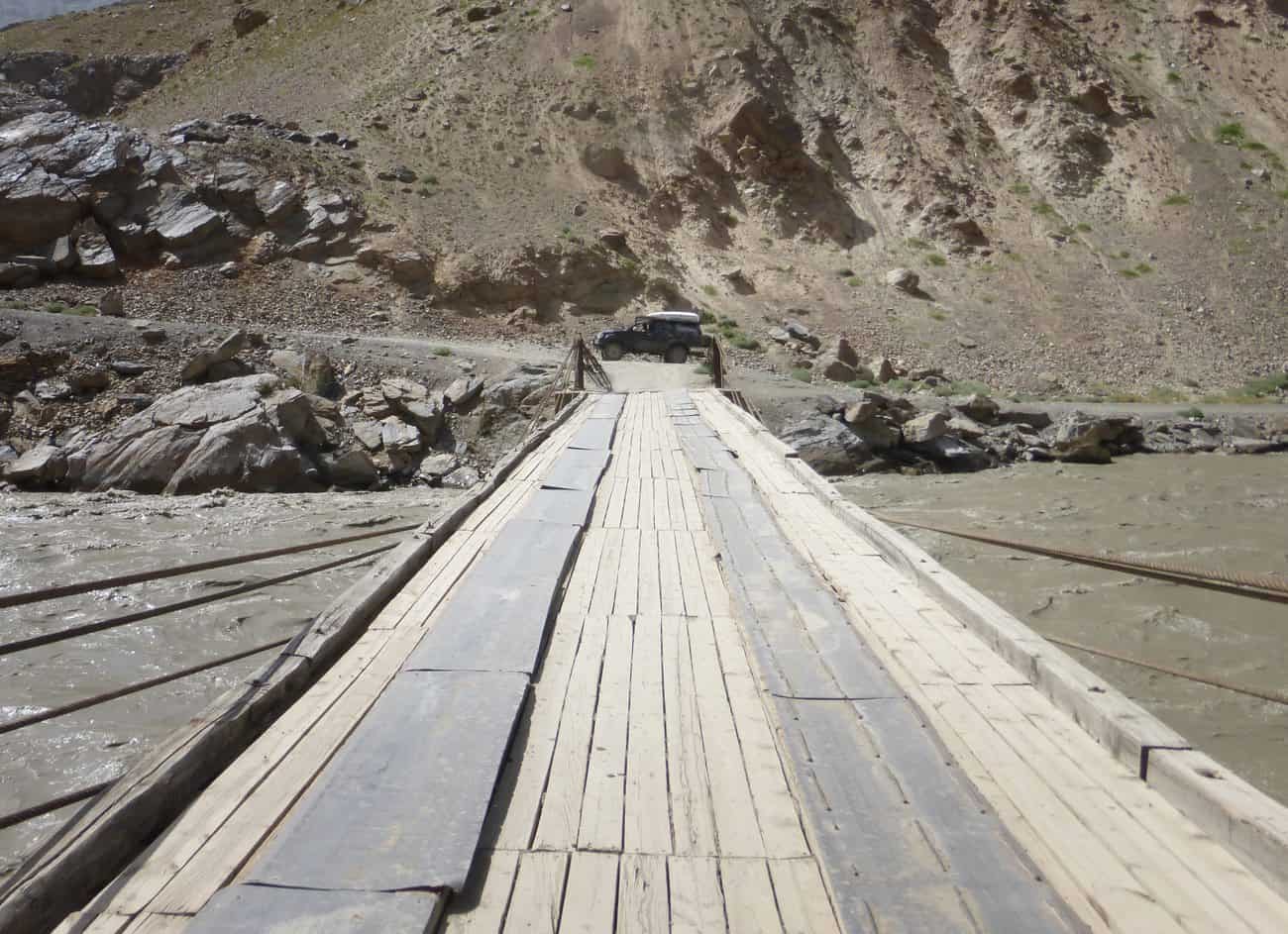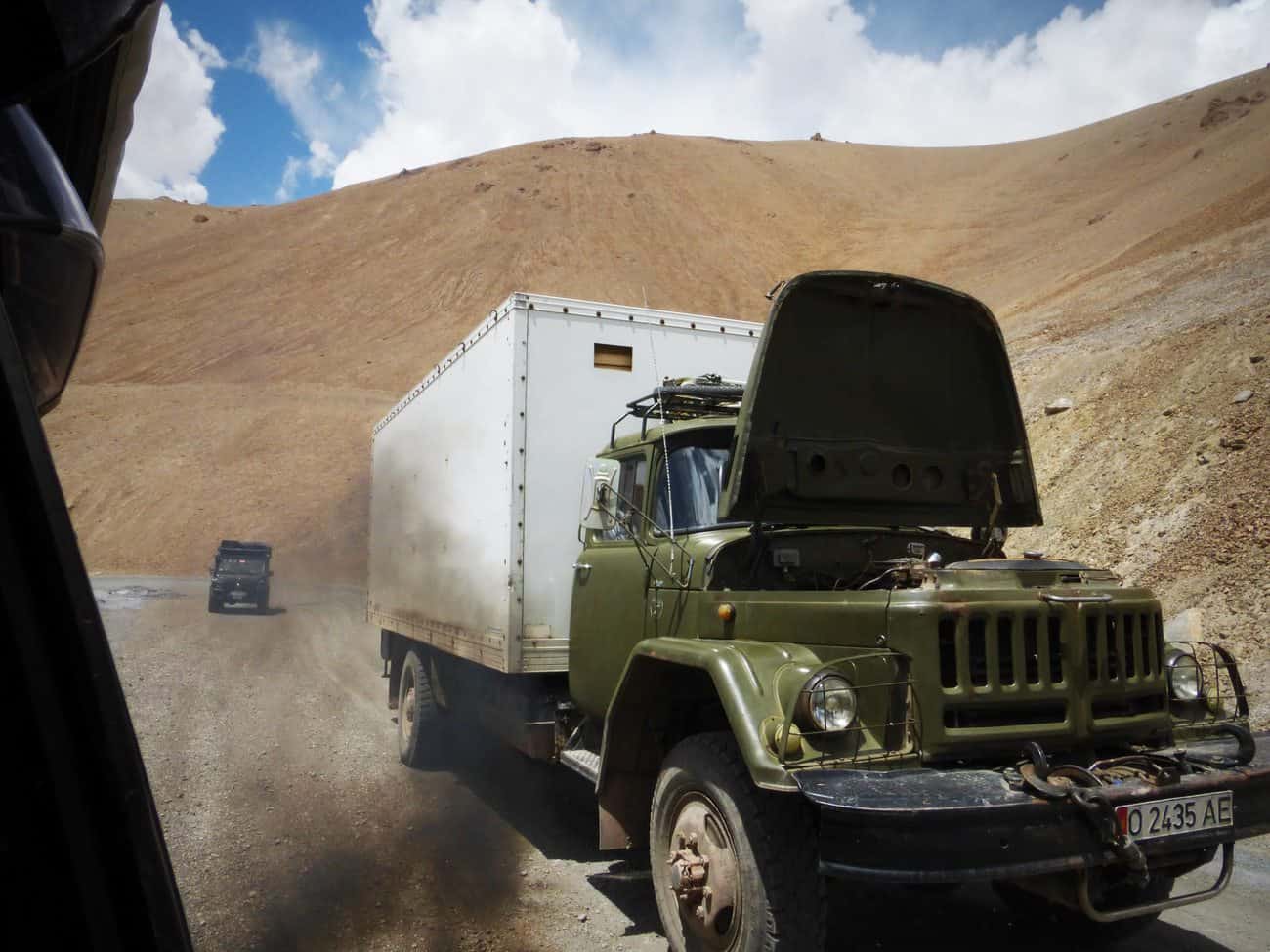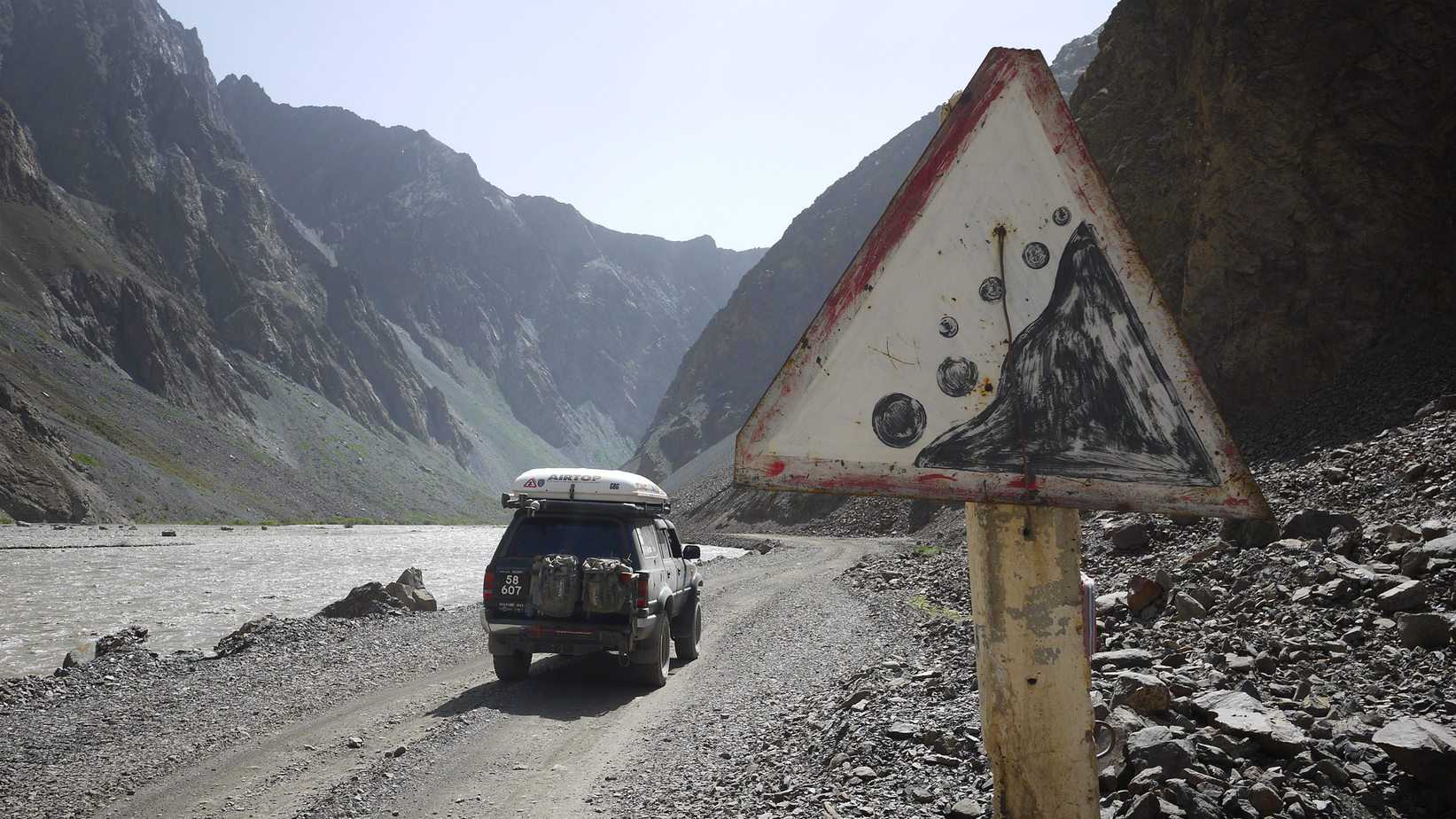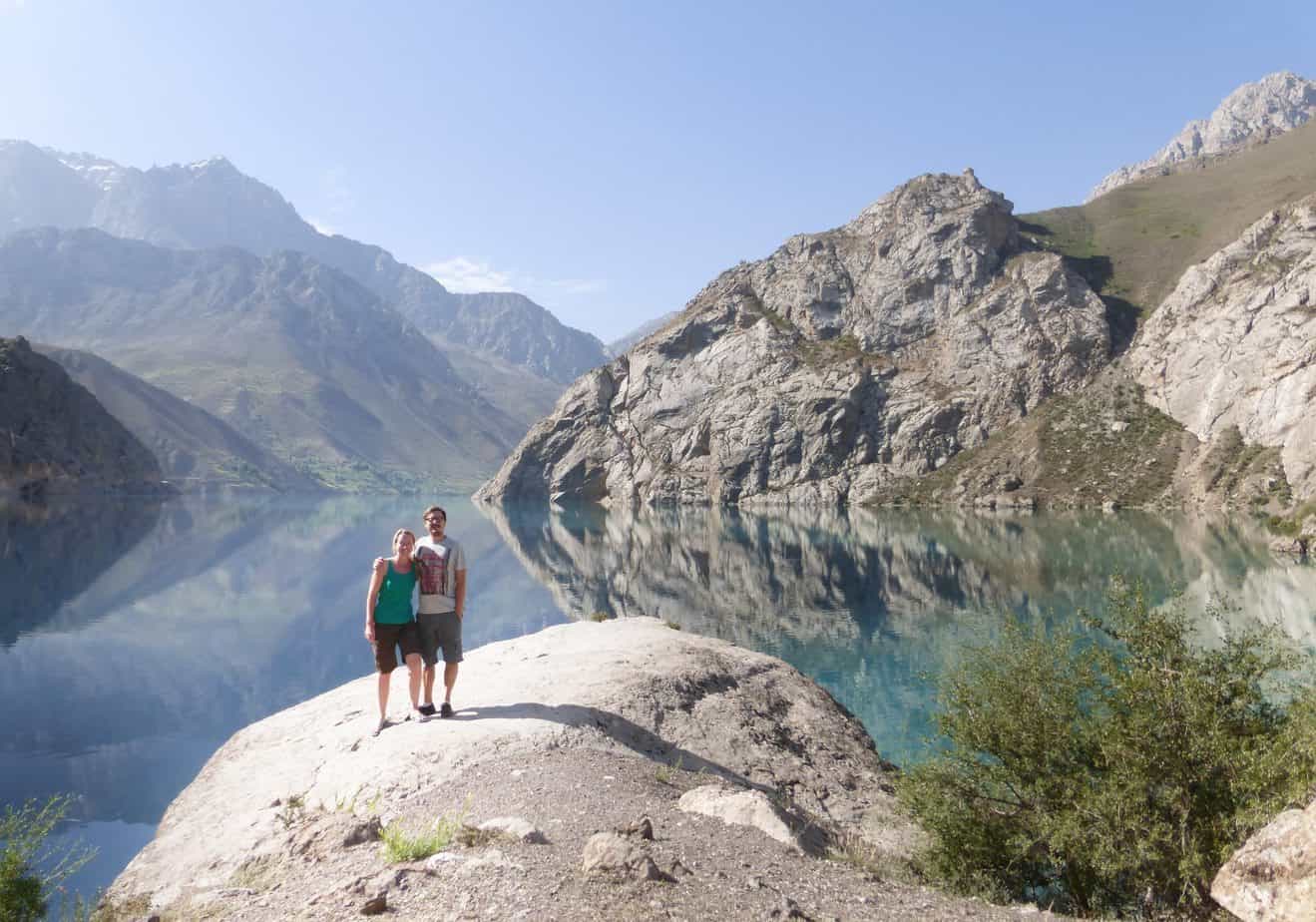Our adventure continued from here up the much greener Shakhdara Valley to the mountain village of Tusion. The rather abrupt snaking climb through the village, in places, was barely wider than the car. Much to our amazement when we reached the summit the last house had a full sized bus parked in its driveway, begging the question how exactly did they get it up there? On the mountain plateau we found an amazing camp spot nestled between two lush peaks. The following day our journey up the Shakhdara Valley was promptly halted, as the typically small river crossing towards the eastern end of the valley had become a swollen deluge and was completely impassable.
With limited options we ventured further north to the bleak Bartang Valley. In places the fragile road inched perilously close to the wide coursing river. The sheer cliffs above climbed skyward out of view and thankfully out of mind as we drove along the insubstantial road. Every few miles you are starkly reminded of the dangers from above; enormous rocks, many larger than the car, litter the edge of the river having been bulldozed off the road.
Read Part one of this story [HERE].
After a mildly distressing 2-hour drive we reached the rather decrepit Soviet bridge where we’d planned to turn up the secluded Ravmeddara Valley. The road after the bridge narrowed further, became rougher and in places was barely wider than the car. The disturbing sight of the powerful river below slowly eroding the road away was enough to ensure we didn’t hang around to take too many photographs. Further up the valley we eventually found an area high enough above the flood plain that was suitable to camp for the night. After inspecting the looming mountainsides for potential rock fall dangers we decided to pop the rooftent and bed down for the night.
Being woken in the middle of the night by a gently rocking car is always a little unsettling. Once the realisation that this was an earthquake sunk in thoughts of our imminent death sprung to mind as we panicked and fumbled for the torch. Thankfully sleep deprived and slightly bewildered by our impending doom we fell straight back asleep once the rumbling had subsided. In the morning the realisation that this was probably a fairly dangerous place to stay dawned on us and we decided it was probably a wise move to leave the valley and the rather swollen river behind us. We hoped the previous nights small earthquake hadn’t triggered a rockslide that would leave us trapped in the increasingly submerged gorge.
Returning to the M41 and now heading towards the capital, Dushanbe, the road re-joined the Afghan border along the Panj River. The river was now a raging brown torrent and was ferociously biting at the edge of the rocky road. Pleased to see the back of the river we headed north towards the city.
From Dushanbe we had one final stop in Tajikistan, the beautiful Seven Lakes in the Hisar Tizmasi range. The only thing that stood in-between us and a chain of serene mountain lakes was the notorious ‘Tunnel of Death’. Cutting through roughly 3-miles of mountain underneath the Anzob Pass the tunnel has become infamous amongst overlanders.
The tunnel is not nicknamed lightly; its lack of ventilation claims several lives each year. Carbon Monoxide poisoning is not the only danger; the tunnel floor is often reported to be under 60cm’s of water hiding a labyrinth of potholes, internal rock falls are common, abandoned tunnel machinery is strewn across the narrow one and a half lanes and to top it off the traffic is not regulated from either end.
We’d heard stories of 4-hour traffic jams and prevailing anarchy whilst you sit in the darkness, your headlights struggling to cut through the fumes of belching trucks.
Unfortunately the only alternative is to drive over the 3,372 metre Anzob Pass which is closed for most of the year due to the weather. The pass itself is classed as one of the most treacherous in Central Asia; avalanches are frequent, there is no safety barrier and the final 12 miles are a 7-8% gradient. In 1997 an avalanche so big it took 2 weeks for rescuers to reach the 15 buried trucks and cars killed 36 people.
With great trepidation we watched the GPS closely, mentally preparing for our next challenge, as we approached the mountain. Either route was less than desirable, but thankfully we were forced to take the lesser of two evils, the tunnel was closed due to flooding.
As we climbed the partially paved road it flitted between crumbling tarmac and rough gravel, slowly deteriorating the higher we ascended. Mercifully the surface was dry and dirty and not muddy, as we’d read. Occasionally we’d slow as oncoming trucks filled the air with clouds of dust obscuring our sight of the perilously close cliff edge.
Once over the pass the descent was relatively straightforward. Not wanting to overheat the brakes due to the extra weight of all our overlanding gear we dumped the automatic gearbox into low and cruised downhill at a leisurely pace thankful to have negotiated what we thought was our final hurdle.
The scenic drive to ‘Seven Lakes’ soon took a turn for the worse. Like in many other countries around the world the Chinese are investing money in Tajikistan building new roads to make the transport of resources they are exploiting easier. Unfortunately for us they hadn’t quite finished yet leaving a partially graded gravel road. The construction workers were blasting a huge piece of rock into the swollen river 150 metres below with dynamite. This closed the road for about 40mins as we watched from about 900 metres away in a row of inpatient Lada drivers. Due to the dust we had to sit with the windows wound up in 32°C, at this point I was being to wish I’d never removed the air-conditioning. Literally two minutes after the explosion the road was reopened, we followed in a long line of cars dodging Chinese bulldozers feverishly nudging rocks over the cliff edge.
The drive up the valley to the Seven Lakes was equally unnerving. The rough mountain roads looked freshly bulldozed implying that rock falls were commonplace.
We climbed on a narrow dirt track, clinging to the rock edge and occasionally dipping down to the shore past the seven lakes, each more beautiful and higher than the last. Each lake changed slightly in colour as we ascended the rough mountain roads, each looking somehow purer than the previous one.
We were unprepared for the breath-taking reward of the sixth lake, a simply stunning azure blue mirror-like surface reflecting the mountains beyond; a perfect ending to an unforgettable adventure through a wild and dramatic country.
Tajikistan offers some outstanding driving and unforgettable scenery that I’m sure will remain a highlight for us as we continue on our travels around the world in out trusty Toyota.
Just two days after leaving the M41 behind us the Tajikistan government declared the whole area a natural disaster zone after glacial snow melt had extensively flooded 3 villages, many valleys and destroyed large sections of the road leaving the local population without electricity. Along the Wakhan corridor over mile of road had completely been washed away.
You can follow Andy and Emma’s adventures at www.aroundtheworldin800days.com or on Facebook.


